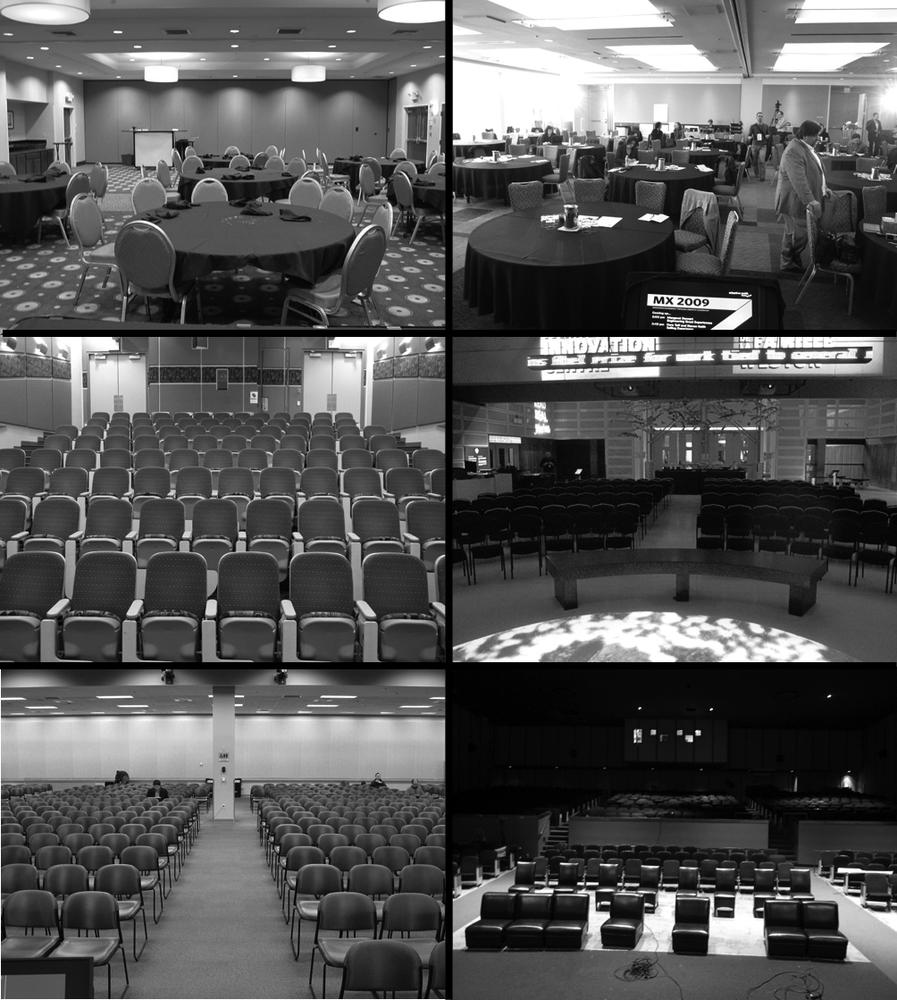Confessions of a Public Speaker (10 page)
Read Confessions of a Public Speaker Online
Authors: Scott Berkun
Tags: #BUSINESS & ECONOMICS / Skills

It
may turn out that if you pick a good title and it’s on turf
you know very well, then like
Lincoln, you won’t have to work very hard to fulfill the
promise the title makes to your audience. And of course, if you are like
Lincoln, you don’t necessarily need an
interesting title to do a great job. The
Gettysburg Address is called the Gettysburg Address because
Lincoln didn’t bother to name it (some historian probably figured, “Well,
he was at Gettysburg, and he addressed the audience, so…”). But remember,
he was the president of the United States and could get a crowd whenever
he wanted one. Unless you’re famous enough to expect people to come
because of your name or distinctive hatware, get to work. The more
effort you put into the clarity of your points, the easier
everything else about public speaking becomes.
Many interesting things happen in the corners, away from the
spotlights. But most pictures of public speaking focus on center stage.
Over the next few pages, you’ll find photos and stories of things I
think you’d like to know.
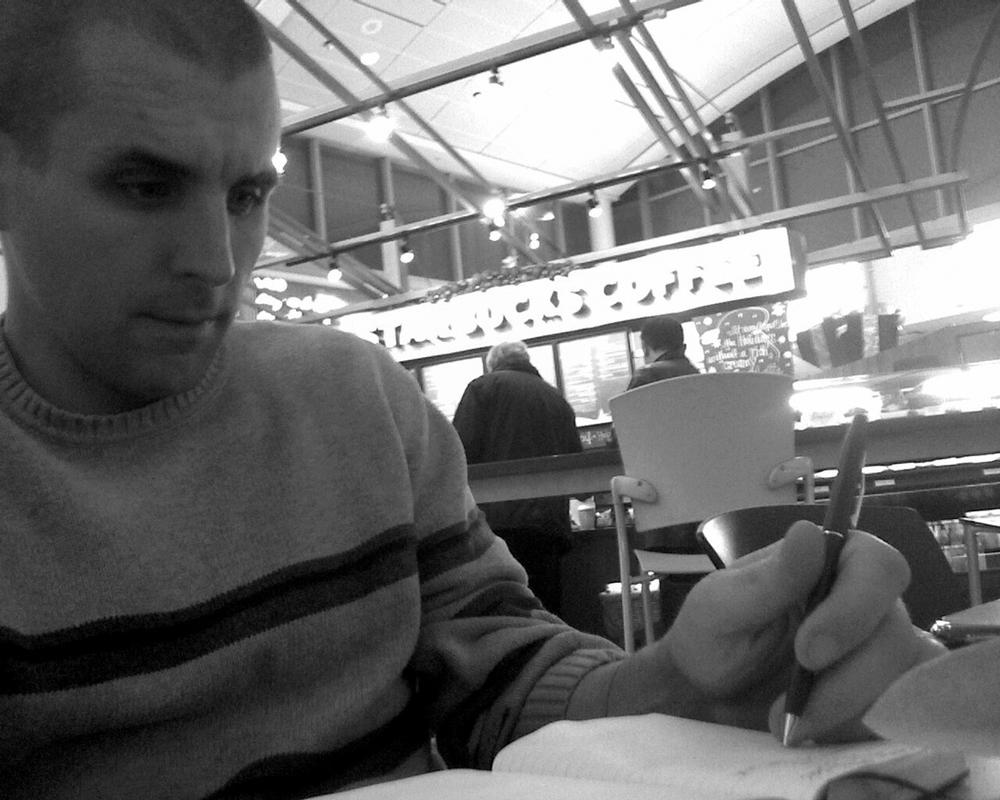
This photo, taken in a Starbucks, reflects what it’s like to
travel to a speaking engagement and be stuck in uninteresting places
along the way. Similar to being in a rock band on tour, there is little
romance in getting from place to place. Even when the gig is somewhere
amazing like Moscow or Tokyo, much time is spent waiting in the boring
places you must go through to get to the interesting ones. Traveling
alone has few upsides, and waiting alone at an empty airport is not one
of them.
This moment was at the Vancouver International Airport at 6:30
a.m. while waiting to catch a 7:30 a.m. flight home. Only Starbucks was
open that early. With nothing else going on, I tried to get some work
done. If you look carefully, you’ll see I’ve achieved several
spectacularly useless doodles.
Travel, however, is excellent for finding new questions to ask, so
I write often while on trips. My technology of choice is Moleskine
notebooks, as shown in the picture above. I never leave home without
one, and there are stacks of journals filled with ideas near my desk at
home. I flip through them when I think I have nothing left to
say.
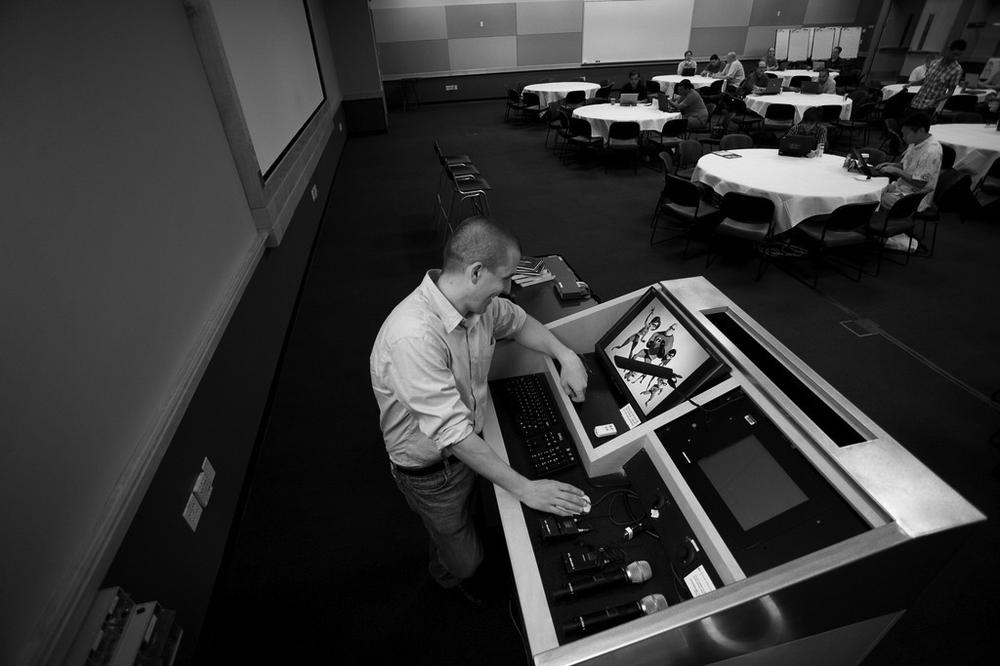
Getting set up is more stressful than the talk itself. Only rarely
are the lecterns as well stocked as this one on Microsoft’s main campus,
which has light controls, a lapel mike, and two microphones for the
audience. In the bottom-left corner of the lectern is a case with pens,
Post-it notes, and other handy things speakers often discover they need
at the last minute.
Some AV staff are first rate pros, and run their rooms as if they
were Carnegie Hall, making sure all the sound and video gear are fine
tuned so I can do well. But some are not, and as I’m in many venues, I
have little time to sort out the good from the bad. My paranoia around
getting set up explains why I prefer to use my own laptop. If my laptop
explodes, I’m to blame, and I’d rather it be my fault than put myself at
the mercy of a tech guy I just met, who may have been hired yesterday
and have even less of a clue than I do.
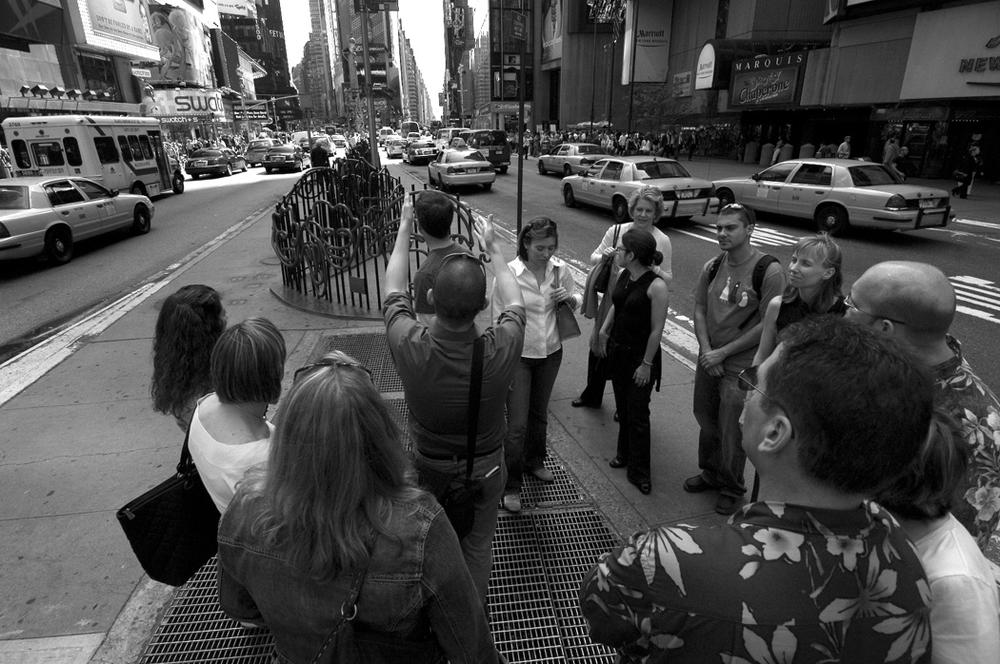
For a few years, I ran architecture tours of NYC, which provided
new public speaking challenges. Hecklers in your own audience are one
thing, but overcoming the distractions created by taxis, buses,
vagrants, and confused tourists (who think you might be their tour
guide) helped make ordinary speaking venues much easier to
handle.
In Times Square, as shown in the picture above, if you can keep
people’s attention for more than 30 seconds—without slides and a
microphone—you’re doing well. If you count the number of people
listening versus those who appear distracted, I was doing pretty well in
this photo. That’s me in the center.
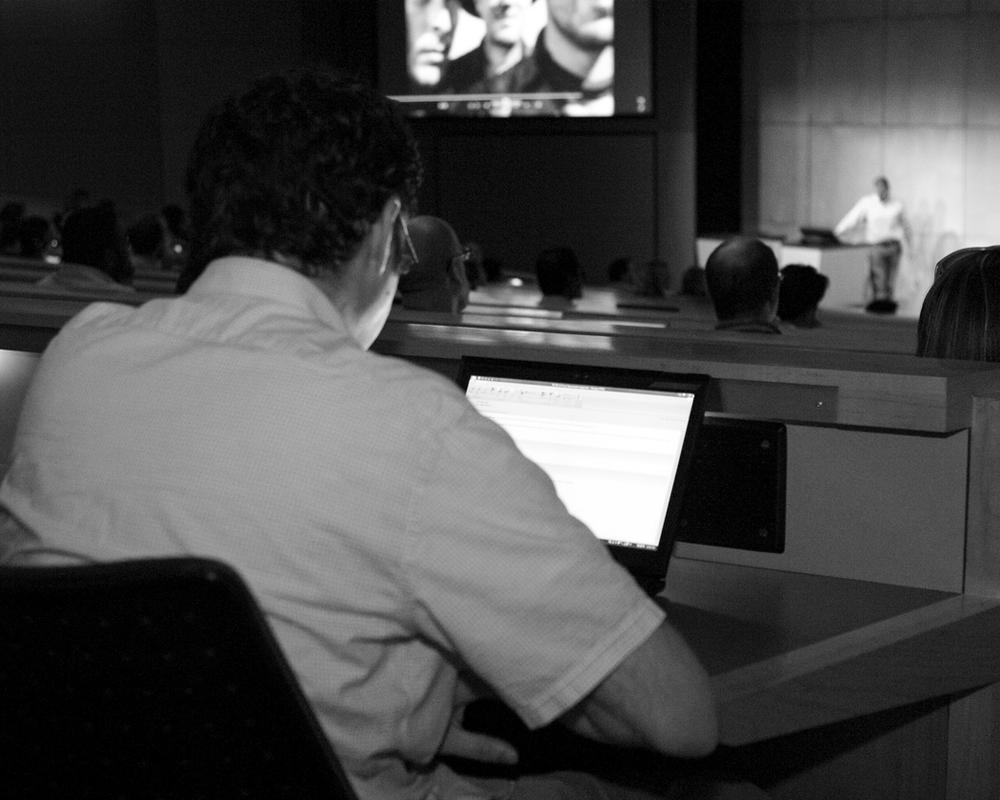
Even when I’m on my game and things are going well, some people
will always be doing something other than listening. Can’t blame them,
it’s just how people are.
Look at how small I am in this guy’s field of vision. It’s very
hard for me to compete with the computer screen right in front of his
face or the cute girl in the next row. For this reason, sit in the cheap
seats before your talk to remind yourself of how much energy you need to
project so that you don’t look like a zombie on stage.
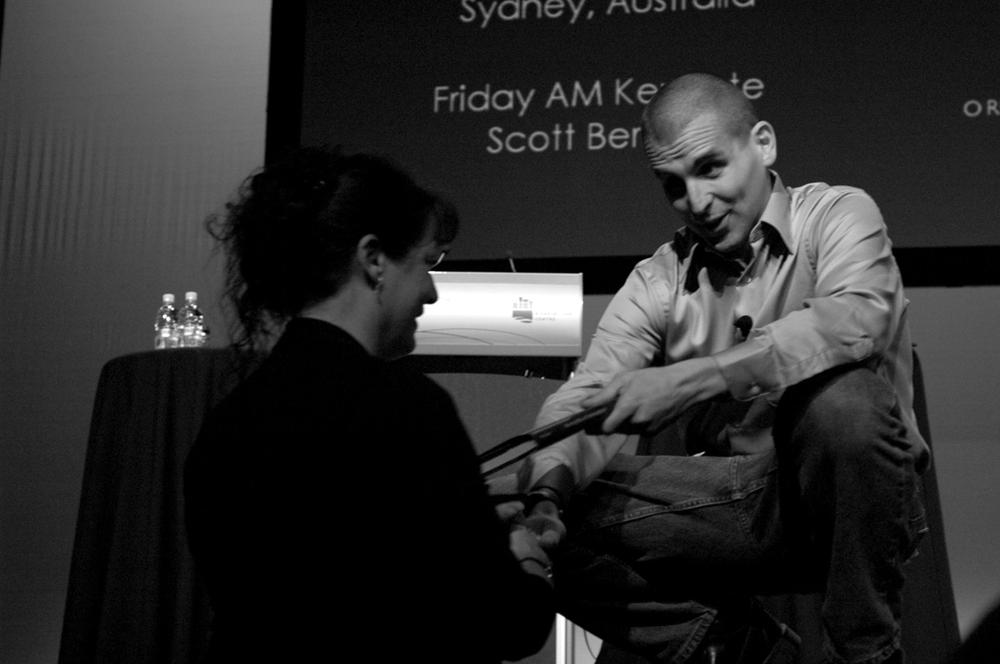
In 2007 I got an email from a woman who found some typos in an
essay on my website. As thanks, I offered to send her a copy of one of
my books. She declined, saying she lived in Australia, which is quite
far away. But ha! I told her I was going to be in her fine country
giving a lecture the next month and could hand-deliver one. As it turned
out, she was going to the very conference I was speaking at. The problem
was, she was shy and would be hard to find. I told her not to worry—I
have my ways.
My solution? I told this story to the audience at the start of my
keynote lecture, who responded with an encouraging round of applause.
Smiling, she came up to the stage so I could give her the book.
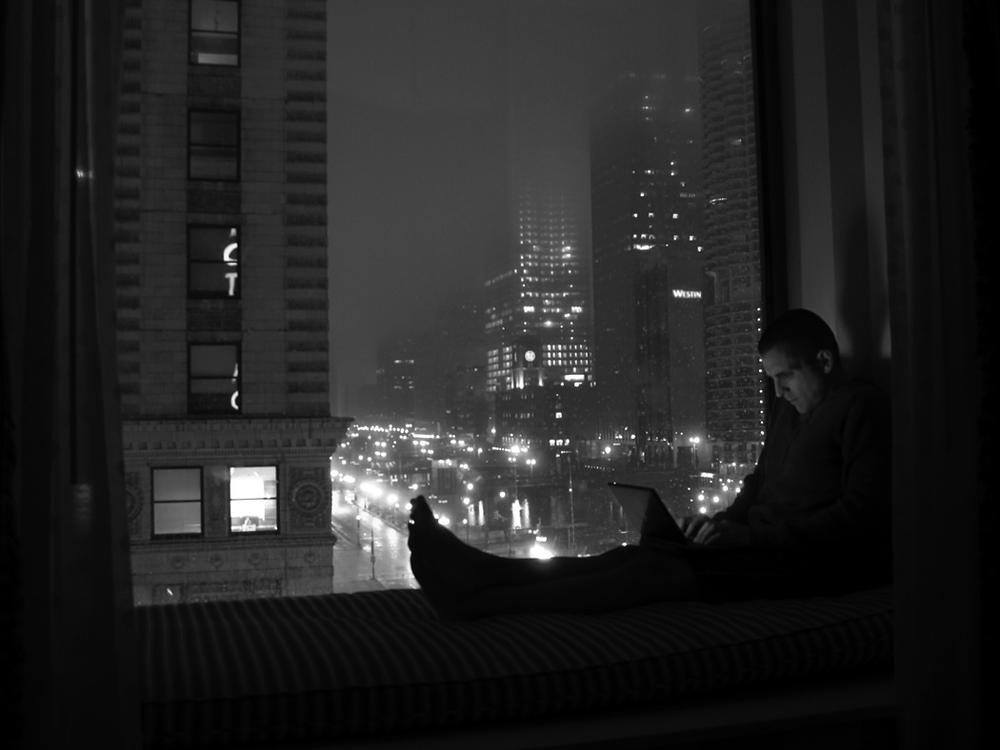
Being invited all over the world means I’m often treated as a
special guest. Sometimes I meet famous and interesting people, and often
there are after-parties and special dinners where I’m the guest of
honor. However, frequently my nightlife looks something like the above,
without the view.
But on this day in Chicago, the travel gods smiled upon me. After
an upgrade to suite 614 at the Hotel Monaco and a fine lecture at DePaul
University, I hid from the cold, rainy February night with an excellent
meal and wine with a friend named Fitz. Riding the buzz of a travel
experience done right in a favorite city, I wrote a good part of
Chapter 3
while sitting in the window of my room, as shown
above. For entertainment, I watched as cops, at 1:15 a.m., arrested a
drunken shoplifter at the 7-Eleven across the street, where I’d bought
snacks hours earlier.

When you strip away all of the layers, like slides and handouts,
public speaking becomes intimate and real. It’s just a person with
ideas. This is how it’s been done for thousands of years. There are good
reasons few comedians use slides or props—those things can get in the
way of connecting with the audience. This explains why I love short
speaking formats like Pecha Kucha and Ignite! where the rules are
different: five or six minutes per talk, and slides that move
automatically or no slides at all. It forces speakers to take risks and
be vulnerable, which always makes things more interesting for the
audience. And it makes them cut most of the bullshit out of their
presentations.
The photo above was taken at Gnomedex ’08 in Seattle, Washington,
during its afternoon Ignite! session. I didn’t do very well that day,
but the experience of doing unusual formats or speaking on new topics
always teaches me something I can use next time.
